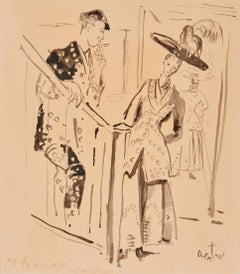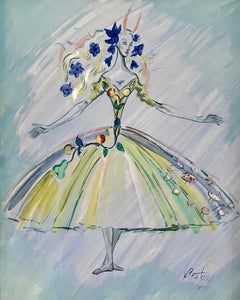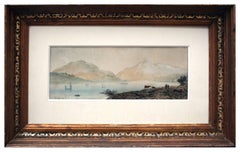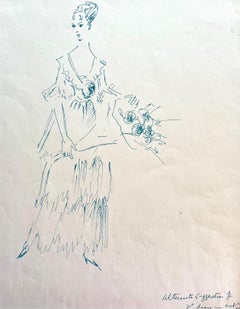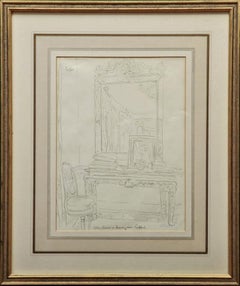Cecil Beaton Figurative Drawings and Watercolors
Cecil Beaton developed a distinctive style of photography where the subject was immersed in backgrounds made of unusual materials such as paper-mâché or aluminum foil. A socialite who rubbed elbows with royalty, celebrities and the wealthy aristocracy, the British photographer captured some of the most famous names of his time.
Beaton was born in London in 1904 to a successful lumber merchant and amateur actor. He received his first camera as a gift at age 11. Beaton later attended St. John’s College in Cambridge and studied art, history and architecture. He dropped out in 1925 and went to work in the family lumber business, but his free time was spent absorbed in photography.
Beaton befriended Sir Osbert Sitwell, who was captivated by his photographs and funded his first exhibition. It was an immediate sensation, leading to work with major magazines.
With a photography contract from Condé Nast, Beaton left for New York. By the end of the 1920s, he had worked as a staff photographer for Vanity Fair and Vogue. He continued to cultivate his unique portraiture style and published his work in several books. One of his greatest achievements was a commission from the British Royal Family in 1939, a relationship which endured for decades. During World War II, he served as a wartime photographer in Africa and East Asia.
After the war, Beaton returned to private portrait commissions. He also began designing costumes and sets for theater and the silver screen, winning an Academy Award for Best Costume Design for Gigi and awards for costume design and art direction for My Fair Lady. He also won costume design Tony awards for the Broadway shows Quadrille, My Fair Lady, Saratoga and Coco.
Beaton designed the sets and costumes for a production of the opera Turandot at the Metropolitan Opera in New York and then at Covent Garden, London. His diaries, which were scrapbooks of his life and interests, have garnered wide interest, and several volumes of them have been published.
On 1stDibs, find Cecil Beaton’s photography, drawings and watercolors, paintings and more.
1950s Performance Cecil Beaton Figurative Drawings and Watercolors
Paper, Ink, Pen
1930s Realist Cecil Beaton Figurative Drawings and Watercolors
Watercolor, Paper
1870s Realist Cecil Beaton Figurative Drawings and Watercolors
Paper, Watercolor
1970s Realist Cecil Beaton Figurative Drawings and Watercolors
Paper, Watercolor
Late 19th Century Realist Cecil Beaton Figurative Drawings and Watercolors
Paper, Watercolor
1950s Realist Cecil Beaton Figurative Drawings and Watercolors
Paper, Watercolor, Lithograph
1940s Realist Cecil Beaton Figurative Drawings and Watercolors
Gouache, Graphite, Pen, Watercolor
2010s Realist Cecil Beaton Figurative Drawings and Watercolors
Paper, Watercolor, Pencil
Early 20th Century Realist Cecil Beaton Figurative Drawings and Watercolors
Gouache, Watercolor, Paper
Early 20th Century Realist Cecil Beaton Figurative Drawings and Watercolors
Gouache, Watercolor, Paper
1920s Realist Cecil Beaton Figurative Drawings and Watercolors
Paper, Watercolor
1940s Realist Cecil Beaton Figurative Drawings and Watercolors
Paper, Gouache
1870s Realist Cecil Beaton Figurative Drawings and Watercolors
Paper, Watercolor
2010s Contemporary Cecil Beaton Figurative Drawings and Watercolors
Paper, Pastel, Ink, Pencil, Color Pencil
Mid-20th Century Realist Cecil Beaton Figurative Drawings and Watercolors
Ink
20th Century Cecil Beaton Figurative Drawings and Watercolors
Pencil
1950s Cecil Beaton Figurative Drawings and Watercolors
Watercolor
Late 20th Century Other Art Style Cecil Beaton Figurative Drawings and Watercolors
Watercolor
Cecil Beaton figurative drawings and watercolors for sale on 1stDibs.
Artists Similar to Cecil Beaton
- 1stDibs ExpertApril 5, 2022When he was young, Cecil Beaton became enamored by the portraits of high-society women and actresses in the newspapers. At age 11, his nurse taught him how to use a camera and develop film. You can shop a selection of Cecil Beaton’s pieces from some of the world’s top art dealers on 1stDibs.
